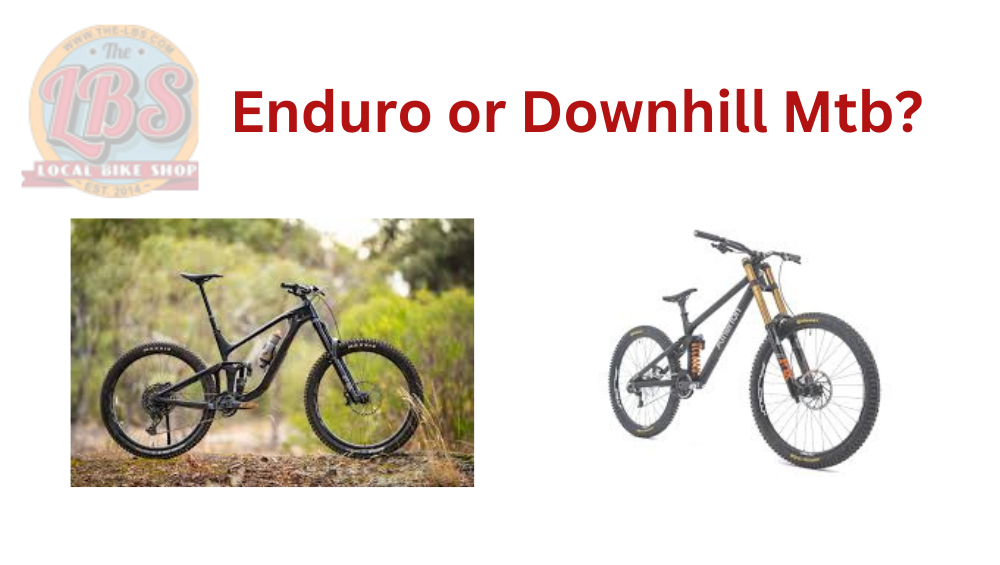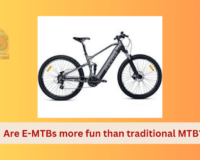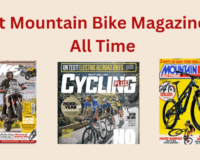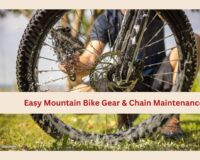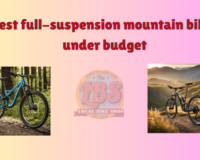A bike is a companion that is always there. Sometimes, even with a general idea of what you want, it can take time to pinpoint the exact thing you’re looking for in your riding journey.
Confusion is where it all starts. We get confused because we have different MTB options, like downhill, hardtail, or enduro. It seems that you not a commuter and already have narrowed down your options in DH and Enduro; for the final chase, let’s compare features, utility, and things that work right and find you a perfect bike.
If you dig a little more, you will understand which one you want to have, and if you have a big budget, you can always buy both at the nearest bike shop. Remember, both the bikes are the type of mountain bike.
“Which mountain bike should I buy?” Quora Edition
There has been a big debate on platforms like Quora and Reddit with real people, real users, and real experience. It’s always good to have references and reviews and how users relate to DH or enduro bicycles. One of the users mentioned,
“Enduro are pretty similar to trail bikes, but they are more oriented to go downhill (thanks to more suspension). If you like rough up-and-down trails and want casual biking, then choose the enduro.”
When you go for features like downhill riding and descending, nothing matches the DH, and they are strong choices and master specialists. With great riding position, dependable top tube, along with proper conditioned handlebar, seat, and hand brake skill, you can make your downhill journey safe alongside with having fun. Let’s see how users find them on Quora.
“If you love to downhill, DH is a great choice for descending. It can give you fun riding in technical, steep, and gnarly terrain, where you can tackle steep descents with no hard use of legs. Downhills are a reliable and strong choice.”
The good words don’t end here for a downhill cyclist; DH bicycles are a must to have to win the marathon, exaggerate power beat personal records, and things to follow.
Downhill or DH bicycles are the real specialists of the mountain biking world. As the name suggests, these bicycles are designed for riding the very steepest and roughest descents. You can’t take them upwards, so you’ve either got to push them or get an uplift back to the top.
Can I not get the best of both Enduro and Downhill features in a mountain bike?
A versatile choice is what we look up to, and it’s not that we take Downhill every weekend, we do it leisurely. When we are a mix of users who want the fun of both worlds on a mountain biking trail, Enduro can be quite a good choice. Lewis Bradley stated, If you want all of everything, here is what you need.
“If you want the best of both worlds (hybrid), I highly recommend a 160mm or 180mm enduro that is capable of tackling everything. A ‘Big Mountain’ enduro cycle will allow you to go upward the slope of the mountain due to the drivetrain (most likely 11 or 12-speed cassette) and will be much lighter than the downhill.”
Narrow your choice: a downhill or cross country ride?
There is a difference between Downhill and enduro; though they aim for the same purpose of having fun on the tracks, downhill and enduro typically are like two genres of a novel. So, Dan, Heavy and light Mechanic and Auto-Electrician added,
“Do you want to ride downhill or cross-country? Answer that question, and you will have more of an idea of which bike you should buy. If you pick a high-travel enduro, you can do some lighter downhill work. In true-to-form modern MTB terminology, the ENDURO is pushing toward monster truck status. “
As the expert’s advice continues, we need to buy a bit more adjustable bike than the DH unless we need the big drops. The DH can be the most suited kind of riding to run down ski slopes, and this can go crazy when you are racing it with like-minded friends.
“Bikers intend to go much faster over 100 kph without total air drag. And for that, the DH is best to have, and this record can be beaten with every new attempt on your own DH bike, not Enduro.”
Are Downhill bikes pointless?
We use things for what they are intended for. If you try to go up the slope with downhill, that’s a pointless approach. DH are for steep, technical, and rough trails with big jumps. A user on Quora added,
“Downhills, on the other hand, emulate earthmoving machinery. They are heavy and slow anywhere but downhill. They are always very stout frames, with very strong wheels, and huge amounts of articulation in the suspension.”
“Downhills are impractical most of the time, but having them can be a privileged position for downtrack. It is a big old thing that comes with a triple clamp fork to give you the stiffness for extra travel,” experienced biker Neil has very well said.
As simple as that, Downhill MTB has greater impact absorption, and despite being heavy, they are durable and have stable performances at high speeds. A lot of modern down tracks are available where DH racing is still a kind of sport.
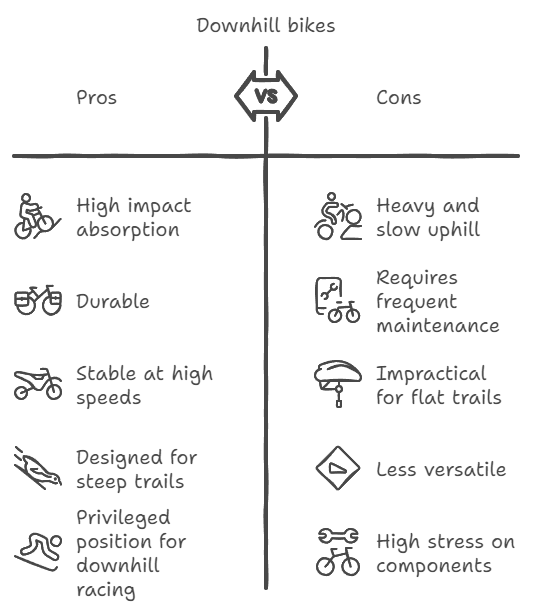
A pretty flipping without getting injured—only DH can give that. On gear seven with the fixed post, these are beasts that can be super stiff and have strong loads without bombing your head on a down track.
However, downhills require more maintenance as they are made for aggressive downhill riding performance with longer suspension. We need to get it checked for the slack head angles and its components so as not to get injured.
It is in fact true that downhills are not that practical for upward cycling or cycling on flatter trails. They require more maintenance due to the intense stress they endure, and their design makes them less adaptive for general trail riding.
Downhill vs Enduro, which is the top selection?
Enduros have endurance on technical sections with adaptable and lightweight build-up despite having a shorter travel suspension. They can still do the long climbs, are agile, but not as well as a hard-trail bike. It has everything that every rider can buy based on their preference.
Modern Enduro bikes are more forgiving for bikers who need to rack to different parts of the bike park or ride varied terrain. And the best part is they can still handle rough terrain with a mix of trails, with cycling both upward, and downhill sections.
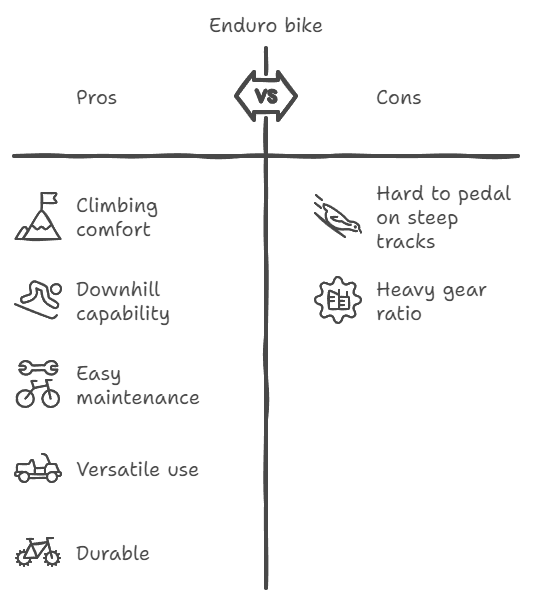
An enduro is likely the better choice, as they are handy and more practical for bikes with climbing comfort and downhill capability. On the brighter side, they are generally easier to maintain and repair than DH bikes.
- Built to withstand rough terrain and off-road to some extent
- Doing the leg work efficiently on both upward and downward inclined hills
- More practical and adjustable for general mountain biking
- Requiring less maintenance compared to downhill bikes
- Providing a balance between climbing comfort and downhill capability.
Enduro bikes is usually preferred because they have this big wide ratio cassette back there at the rear, so gear can be really hard to rack up and down as required in a ski lift-like track. Even for the steepest of the hill, you have no complaints whatsoever. You will be able to ride this all day. Get yours Hope HB 130 on sale today!
Which is preferred, Enduro vs Downhill: Versatility vs. Specialization?
The main difference between a downhill and the enduro is their weight. Downhills are not feasible for those looking for daily rides because of their heavy-duty components. In that case, Enduros can be the bike you can look up to.
“Enduros are more nimble and easier to throw around compared to the downhills. These are the go-to bikes for a new era. They are lighter and requires easier foot work, making them practical for riders who need to use their legs to different parts of the park or trail.”
Neil & Rich are out in Saalbach to pit, where Neil argues, “Downhills are still king of the hill; better drop some trail and keep pushing; you can figure out which is the beast.”
If you prioritize extreme downhill performance, you can have the downhill bike. If you are not sure what your riding style is and want to figure it out with lift services and more on other pedaling and steep sections, Enduro can grant you a chance to be a companion to discover your riding style.
“Enduros are noted for their ability to pedal well on trails and handle climbs without too much effort. This is in contrast to the downhills, which are much harder to pedal upward due to their weight and the extra rolling resistance of their big tires.”
However, enduros are less stable at high accelerations and can have safety concerns on big hits. But don’t you worry, folks; with the right technique, you can still overcome the challenges.
When and where would you use a DH bike?
Have you ever ridden a downhill? If so, what was your experience like? In terms of adaptability and practicality, DH MTB is not a recommendation, nor is it for everyday use, but the feel is real; when you go down on high speed in skis and beat your record, no enduro can match. It’s for marathon players; not everyone has to own it.
“If you were to own a downhill, when and where would you use it?” ask yourself that first. It’s hypothetical, but mostly do you also intend to use it at a downhill mountain bike park or on a designated downhill trail?
When your intended use and interest align with the bike’s natural functionality, why hesitate? You can also get a downhill bike today. Buy an enduro or a DH, it’s your choice. Real-time insights of our trainers are like
“A downhill bike is super specialized like a drag car is for a specific aspect of motorsport; you don’t pedal a downhill bike up the hill; it’s designed for going down your own very steep, rocky, jumpy mountainsides. “
Before you do anything else, take a motorcycle safety course. Who else agrees with what users have to say? You need to know what the purpose of the bike is before finally getting it.
You will barely succeed at your attempt to ride a downhill bike uphill. “These are heavy, and free rides give you pain in the butt. Unless you ride seriously hardcore, a downhill is too much. Buy what you want, but you’ll only ride what you like.”
Who Should Ride a Downhill Mountain Biking?
“Downhill racing is often considered Formula One of mountain biking,” says Paul The Punter. Pro riders push these bikes to the absolute limit, reaching speeds that seem impossible to most of us. But what can these downhill bikes do for the average rider? Let’s find out!
These are designed to be taken to the edge and still survive. Nothing is as good as it is for downhill racing, and when you finally have a downhill, you will know why legends call it a beast. Grassroots and local racing competitions happen everywhere, and when you have a bike that has a lesser impact on your speed, will that hold on to you?
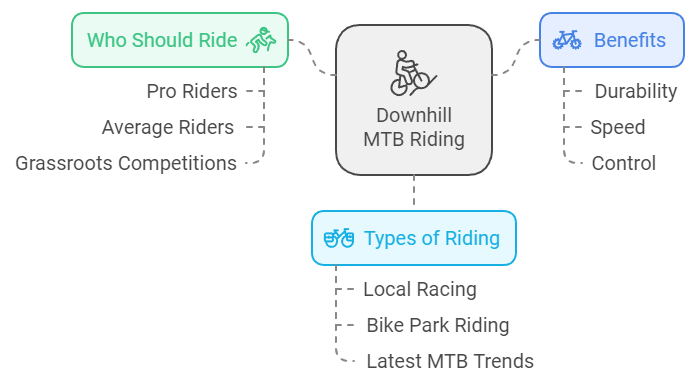
Well, this side of the sport is best supported when you have a downhill bike. You here get as many laps as possible with a downhill bike, and a regular bike park rider might not be very interested in a downhill bike.
DH also supports you in trying the latest MTB trend with high-rise bars and is worth it; you won’t fall off a cliff when you know how to ride this beast. If you are on the fun side, DH is the one for you. Plus, DH bike is also known for its durability.
Conclusion
It messes with your head not knowing what exactly to buy, but don’t forget your helmet. Your research is backed up by our factual insights and guide— any time you can shop with the LBS team. We have brands that are not only top-notch for Downhills or Enduros but are overall the best in mountain bike trends all around the world, with customizable options, accessories, and kits. Contact us today for more info.
FAQs
1. What is a better downhill MTB, Canyon Sender, or Specialized Demo 8?
The Canyon Sender is also a high-performance downhill bike that has playful technical riding and is suitable for racing too. These come with carbon frames and are more on the lighter side, but most say they have speed and agility. The brand claims they have fresh wheel sizes, more control, and are responsive to ride with better suspense too. Definitely, one to check out!
Specialized Demo * has the confidence you look for in a ride, with “full gas on the ride.” A $3,200 that rails through rock gardens and adds more thrill to your Dh racing. Canyon Sender is more on the pricier side, and trust me when I say, price is not the sole factor to judge which is the best to get; not with premium pricing comes an absolute feature.
2. What are the best enduro bikes of 2025?
Shuttle runs, bike park laps, Alpine traverses, and fast-paced post-work rides on your favorite home trails—modern enduro bikes serve it all. These bikes come with robust specs and generous suspension reserves.
- Canyon Strive CFR LTD
- GIANT Reign Advanced 1 V2
- RAAW Madonna V3
- Santa Cruz Megatower GX AXS RSV
- Yeti SB160 T3
There are many options we can explore based on our unique needs. Here we have come across 5 main bikes with tremendous performance, high pivot suspension, and a unique look. This bike stood up in every category, with countless customization options.
Yeti SB160 T3—it’s a wringer both in the bike park and on epic backcountry expeditions, and this shall easily keep up with both downhill and trail rigs.
3. What are the main differences between downhill and enduro bikes, when it comes to tire?
Enduro and Downhill bikes are best known for their wider tires, of 2.4 to 2.6 inches. They have tough casings to enhance traction and puncture protection on harsh impacts on rough terrain. However, downhill bike wheels are heavier to withstand high speeds and can be relatively wider with higher knobbles.
Enduro’s need a balanced grip for better rolling efficiency, but these are built-in downhill bikes. Their wheels have more aggressive tread patterns and are less extreme. That does not mean they cannot transfer efficiency between stages, but the riders need to understand this phenomenon.
Downhill bikes have softer compounds for technical descents and necessary traction, while enduro bikes have harder ones to balance the grip in a range of terrain.
Enduro tires are typically lighter, responsive, and easy to maneuver. They have a versatile build with tread patterns to better protect against punctures and cuts on loose dirt, rocks, and roots. They have easy transfers and are easy to pedal uphill. Also, they flat out less than DH ones.
4. How does the weight of a bike affect its downhill speed?
Downhill bikes are generally heavy, and there is a science behind it. Its weight corresponds to its speed impact. Even without motor assistance, a heavier e-bike will descend faster than a lighter carbon fiber bike due to its increased momentum.
This is because gravity pulls on all objects with the same acceleration, regardless of their weight. However, wind resistance can affect the speed of falling objects. All these are considered in the build of a DH bike.
5. Should women buy an enduro or downhill MTB?
Women pro cyclists are incomparable to men, and yes, women’s bikes are rather low-seated and come in lighter options. Their choice of MTB also depends on their use, like other men in the racing competition or regular ride. If women enjoy longer suspension travel with a longer wheelbase for a downhill track, the DH MTB is the one to grab. If not, options are open for adjustable ones like Enduro MTB.

